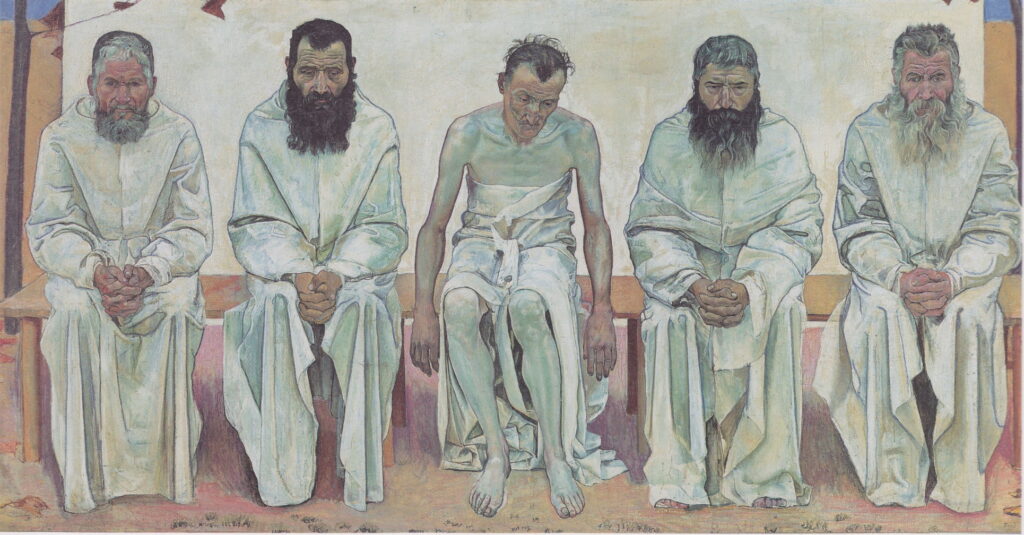Reading Visual Art: 207 Friezes A

In architecture, a frieze is a section of a building above the columns or walls and below the roof, commonly the location of decorative sculpture or a bas-relief.
Leo von Klenze (1784-1864) (architect), (German Victory under Arminius in the Battle of Teutoburg Forest) (c 1842), stone pediment freeze on the north side of Walhalla, Donaustauf, Bavaria, Germany. Image by Brego, via Wikimedia Commons.
This is the monumental hall of Walhalla, commissioned in the nineteenth century as a memorial to the great figures of German history. On its north side is this pediment frieze showing the victory of Arminius and the Germanic tribes over the Romans at the Battle of Teutoburg Forest. This is an unusual frieze as it adds more depth to the figures than would appear in a normal relief.
Lawrence Alma-Tadema (1836–1912), Phidias Showing the Frieze of the Parthenon to his Friends (1868), oil on canvas, 72 × 110.5 cm, Birmingham Museum and Art Gallery, Birmingham, England. Wikimedia Commons.
The most famous is shown in Lawrence Alma-Tadema’s beautiful painting of Phidias Showing the Frieze of the Parthenon to his Friends (1868), whose admiring figures include Pericles (at the right), Aspasia, Alcibiades and Socrates.
In two-dimensional visual art, particularly painting, the term frieze is also used to describe an arrangement of figures that are flattened into a plane parallel to the plane of the picture, thus resembling those seen in architectural friezes.
Artist not known, Dionysian Rites (before 65 CE), Room 5, Villa of the Mysteries, Pompeii, Italy. By WolfgangRieger, via Wikimedia Commons.
Among the most spectacular wall-paintings of Pompeii are those in the Villa of the Mysteries showing Dionysian Rites from before about 62 CE. Room 5 contains a frieze of 29 figures at nearly life size, apparently depicting a sequence of ritual events involving a mixture of Pompeiians and deities.
In the period before three-dimensional linear projection became widely adopted in European art, many paintings adopted a similar approach for groups of figures. But long afterwards the frieze continued to be used in the right circumstances.
Masaccio (1401–1428), The Adoration of the Magi (1426-7), tempera on poplar wood, 21 × 61 cm, Gemäldegalerie, Berlin. Wikimedia Commons.
Masaccio’s Adoration of the Magi (1426-7) delivers a frieze-like view of this popular subject. The Virgin Mary is sat on a golden portable folding chair decorated with lion heads and paws, the infant Christ on her knee. To the left of her is the standard group of ox and ass in a shed, and behind her is Joseph, holding one of the gifts from the Magi. Hints at depth are given in the heights of some figures, but they are confined to a shallow plane parallel to the picture plane.
Raphael (1483–1520), The Marriage of the Virgin (Il Sposalizio) (1504), oil on panel, 170 x 118 cm, Pinacoteca di Brera, Milan, Italy. Wikimedia Commons.
When Raphael painted The Marriage of the Virgin known by its Italian name of Il Sposalizio (‘the marriage’), in 1504, he combined the frieze of figures in the foreground with grand architecture expertly projected in depth. This demonstrates the contrast between the flat frieze in the foreground and the depth of the building behind.
Some motifs are prone to creating frieze effects, and painters have gone out of their way to avoid that.
William Blake Richmond (1842–1921), An Audience in Athens During Agamemnon by Aeschylus (1884), oil on canvas, 215 x 307 cm, Birmingham Museum and Art Gallery, Birmingham, England. Wikimedia Commons.
William Blake Richmond’s An Audience in Athens During Agamemnon by Aeschylus from 1884 is a study of the enraptured audience of a play. Its classical setting has strong formal symmetry, with its central figure perhaps representing the playwright himself. Richmond uses greatly exaggerated aerial perspective, with intense chroma in the foreground falling off rapidly towards the back of the theatre, to give depth to what would otherwise have appeared flat and frieze-like.
Late in the nineteenth century some artists like Ferdinand Hodler adopted frieze effects.
Ferdinand Hodler (1853–1918), The World-Weary (1892), oil and mixed media on canvas, 150 × 294 cm, Neue Pinakothek, Munich, Germany. Wikimedia Commons.
Hodler’s World-Weary (1891-92) was an important early work in the development of his style of Parallelism, with its emphasis on the symmetry and rhythms seen in society. He painted this frieze from models who sat for him in a local cemetery during the autumn of 1891.
Ferdinand Hodler (1853–1918), The Disappointed Souls (1892), media and dimensions not known, Kunstmuseum Bern, Bern, Switzerland. Image by Sailko, via Wikimedia Commons.
The Disappointed Souls (1892), another in this series, also shows five older men, this time dressed in black robes and sat on a bench in barren fields.




